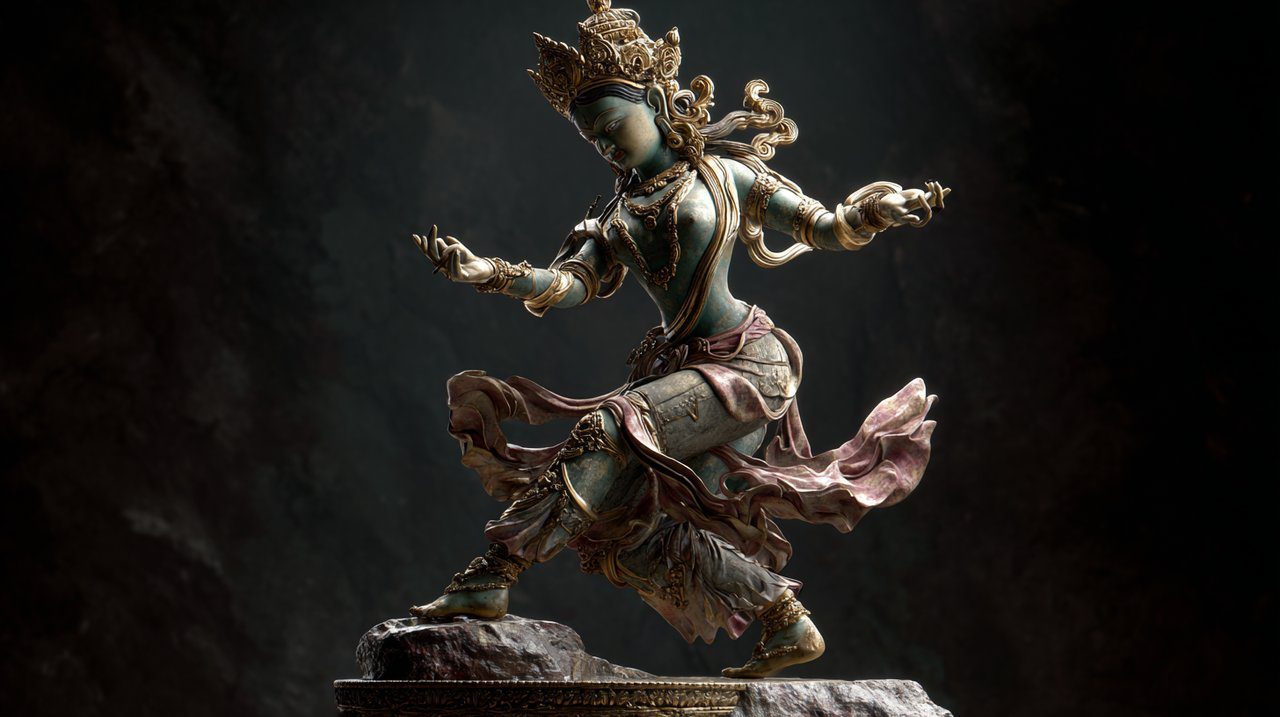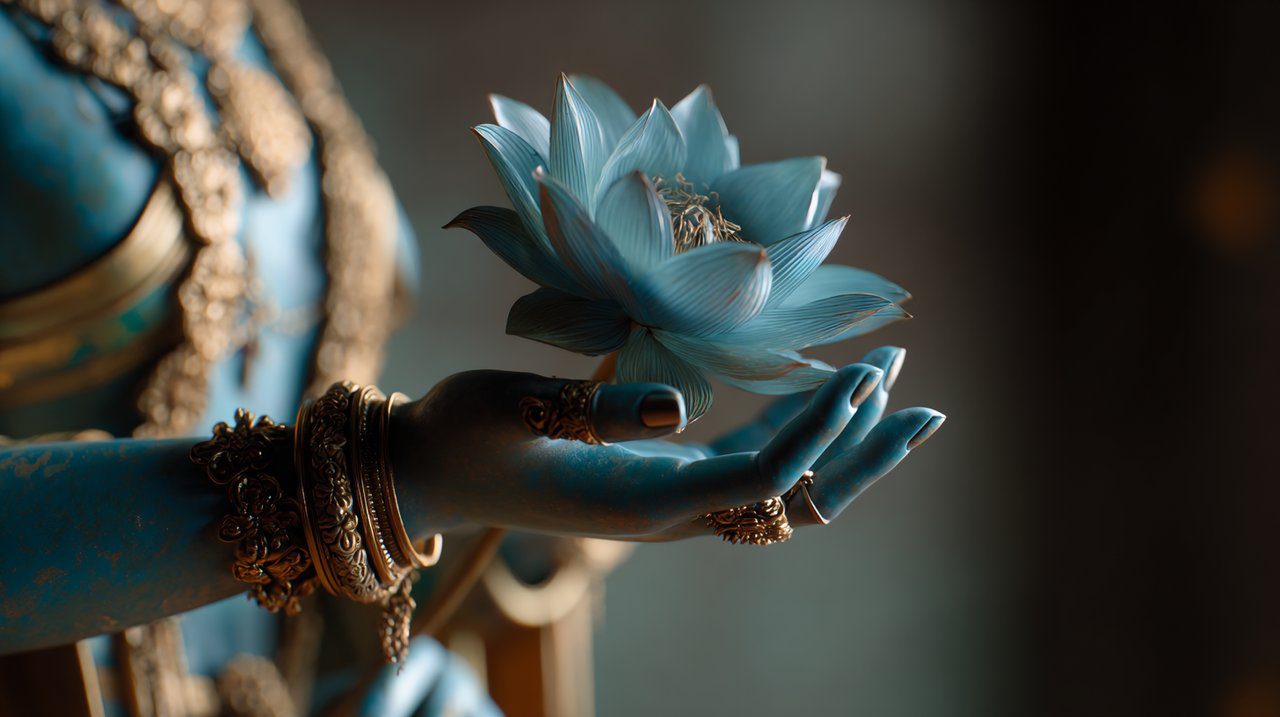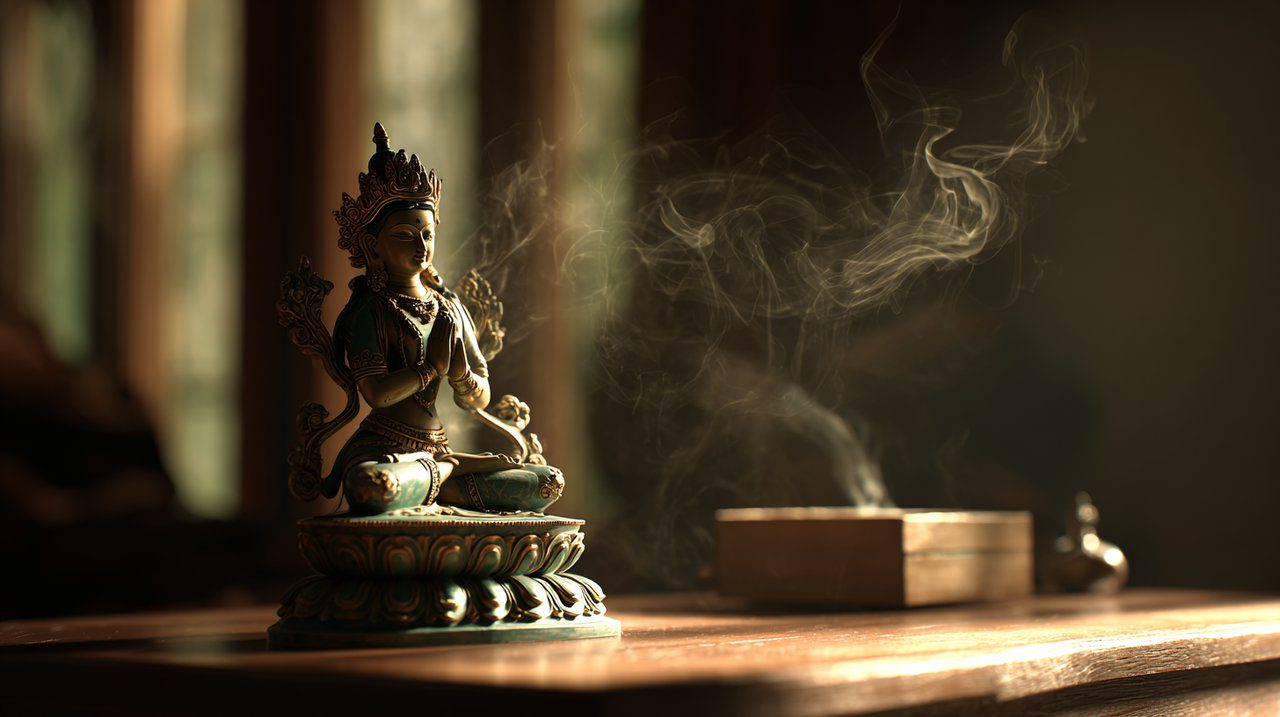Standing Green Tara Statue: Your Guide to Swift Protection, Active Compassion, and Overcoming Obstacles
What truly sets the Standing Green Tara apart from other revered enlightened beings? More than just an artistic variation, her dynamic posture reshapes our entire understanding of divine protection and boundless compassion. This isn’t merely a pose; it’s a powerful visual statement, signaling an immediate readiness to engage with the world’s suffering. Understanding this unique depiction is key to grasping Tara’s role as a swift savior and compassionate guide.
The Dynamic Presence: Unpacking the Standing Green Tara
The standing posture of Green Tara marks a significant difference from the quiet, contemplative stillness we often associate with other Buddhist figures. This stance instantly communicates a sense of urgency and active engagement with the world. It’s a direct, visual representation of her sacred vow to alleviate suffering without a moment’s delay.
The Standing Green Tara symbolizes an immediate readiness to act, offering swift assistance to all who call upon her. This active stance provides a unique perspective within Buddhist iconography, highlighting a dynamic form of enlightened activity.

Symbolism of Readiness and Action: A Closer Look at Her Stance
Observe her posture closely: Green Tara’s right leg is typically extended forward, poised as if she’s about to step down from her lotus throne. Meanwhile, her left leg remains bent, maintaining contact with the throne. This beautifully illustrates her **grounding in wisdom and meditation** even as she prepares for action.
This dual posture masterfully communicates two crucial aspects: her **readiness for immediate action** and her **unwavering stability**. It reflects a constant state of vigilance and profound compassion. More than that, it teaches us that liberation isn isn’t just a static state of inner peace; it’s also an active, ongoing process of benefiting others.
Beyond Contemplation: Why Active Engagement Defines Her
Here’s where the true distinction lies: most Bodhisattva statues are depicted in seated meditation poses, symbolizing deep contemplation and inner peace. The Standing Green Tara, however, fundamentally shifts this focus.
She moves from internal reflection to external, proactive intervention. She embodies a powerful force that steps directly into the world’s chaos, not merely observing suffering but actively moving towards it to provide aid. This contrast underscores her unique characteristic as the “Swift Saviouress,” making her posture a powerful symbol of active compassion and immediate presence.
Swift Protection Embodied: Understanding Tara’s Immediate Response
The active posture of the Standing Green Tara directly correlates with her fundamental function as a protector. She is frequently invoked by those facing fear, obstacles, or danger, with the promise of **rapid relief**.
Her watchful gaze and outstretched hand are clear symbols of her protective energy. This commitment to swift action is a cornerstone of Tibetan Buddhism, making her a particularly relevant figure for navigating the challenges of our daily existence. Many practitioners turn to her specifically when seeking immediate intervention.
Dispelling Fears and Obstacles: Her Vigilance in Detail
Green Tara’s iconography offers further insights into her protective role. In her left hand, she often holds a blue lotus, symbolizing purity and power. Her right hand, in the **varada mudra** (the gift-giving gesture), is open and facing outwards, perpetually ready to bestow blessings and protection.
These elements collectively reinforce her role as a **dispeller of fears**. She watches over all beings with unwavering attention, much like a mother guarding her child. This constant vigilance ensures she is prepared to respond to any call for help, offering a profound sense of security.

The Power of Her Mantra and Gaze: Direct Connection
Reciting the Green Tara mantra—Om Tare Tuttare Ture Soha—is a central practice for invoking her protective energy. This mantra is believed to forge a direct connection between practitioners and her compassionate mindstream, with its syllables encapsulating her very essence and power.
Her gaze, often depicted as direct and penetrating, is simultaneously filled with profound kindness. This isn’t a passive look; it actively seeks out those in need, offering comfort and strength. It serves as a powerful assurance that practitioners are seen, understood, and supported.
Cultivating Active Compassion: Green Tara as a Living Example
Beyond her role as a protector, Green Tara’s standing posture offers us something more: a clear blueprint for cultivating **active compassion** in our own lives. She beautifully exemplifies how profound wisdom and deep empathy can translate into tangible, beneficial actions.
Her very presence is a testament to engaged spirituality. Her example encourages us to move beyond simply contemplating compassion, inspiring us to proactively address suffering in our immediate environment. This, truly, is a crucial aspect of the spiritual practice path.
Emulating Tara’s Benevolence: Practical Steps for Daily Life
- Offering a kind word or a listening ear.
- Providing practical help when someone is struggling.
- Simply being present and attentive to those around you.
Just as she steps down to meet suffering directly, we too can step forward to offer support. This proactive approach transforms abstract ideals into concrete, impactful gestures, fostering a deeper sense of interconnectedness with all beings.
The Bodhisattva Path in Action: Key Lessons from Tara
The Bodhisattva path is defined by a profound commitment: to attain enlightenment not just for oneself, but for the benefit of all sentient beings. Green Tara’s standing posture is a perfect, vibrant illustration of this path in action.
She represents the Bodhisattva who simply does not rest until all suffering is alleviated. Her active engagement teaches us a powerful truth: true compassion demands **effort and courage**. It means facing challenges head-on, rather than retreating from them. This crucial lesson is evident in her every sculpted detail.
Integrating the Standing Tara into Your Spiritual Practice: A Practical Guide
Bringing the image of the Standing Green Tara into your spiritual practice can profoundly deepen your connection to her active compassion and protection. Her presence serves as a constant reminder of her vigilance and readiness.
This integration can manifest through various forms of devotion, making her energy accessible. Her image becomes a focal point for intention and transformation, helping to ground abstract concepts in a tangible form.
Choosing and Placing Your Tara Statue: More Than Just Decor
When selecting a Standing Green Tara statue, we recommend choosing one that genuinely resonates with your personal spiritual journey. The act of choosing itself can become a profound form of devotion, as the statue should inspire feelings of hope and protection.
Once chosen, place the statue in a clean, respected space—perhaps an altar or a dedicated meditation corner. This not only honors her presence but also creates a sacred space for contemplation and prayer, serving as a powerful visual anchor for your practice.

Daily Devotion and Inner Transformation through Tibetan Buddhism and Buddhist iconography
Daily practices, such as offering water, incense, or flowers before the statue, are simple yet powerful ways to deepen your connection. These small rituals reinforce your intentions and devotion, creating a rhythm of mindfulness and respect.
A key practice involves visualizing the Standing Tara actively coming to your aid or radiating compassion outwards. This form of meditation, central to Tibetan Buddhism, helps cultivate her qualities within yourself. Engaging with Buddhist iconography in this way is truly a powerful tool for inner growth and transformation.
A Beacon of Hope: Embracing Tara’s Enduring Legacy and Our Role
So, as we’ve explored, the Standing Green Tara statue is far more than just an artistic representation. It is a dynamic symbol of unwavering protection and, crucially, **active compassion**. Her unique posture fundamentally shifts our focus from passive contemplation to immediate, benevolent action.
This distinctive stance encourages us to embody her core qualities: swift response and profound care. Her enduring legacy invites each of us to confront challenges with courage and to actively extend our compassion to those around us. By integrating her wisdom into our daily lives, we too can become beacons of hope.
Ultimately, her presence inspires us to step forward with confidence and kindness, transforming obstacles not into roadblocks, but into powerful opportunities for growth. This is the true essence of her dynamic, compassionate wisdom.
💡 Pertanyaan yang Sering Diajukan
The Standing Green Tara is distinguished by her dynamic, standing posture, which signifies an immediate readiness to act and engage with the world's suffering, unlike the seated, contemplative poses often seen in other Buddhist iconography. This stance emphasizes her role as a swift savior and active protector.
Her typical posture features the right leg extended forward as if stepping down, while the left leg remains bent. This dual pose illustrates her grounding in wisdom and meditation while simultaneously signaling her readiness for immediate action and her unwavering stability in offering assistance.
Green Tara's right hand is often depicted in the varada mudra, the gift-giving gesture. This open hand facing outwards symbolizes her perpetual readiness to bestow blessings, protection, and assistance to those who call upon her.
The Standing Green Tara serves as a model for active compassion by demonstrating how wisdom and empathy can translate into tangible actions. Her example encourages practitioners to move beyond contemplation and proactively address suffering by offering help, support, and attentiveness to those around them.
Integration can involve choosing a statue that resonates personally, placing it in a respected space like an altar, and engaging in daily devotion through rituals like offerings. Visualizing her radiating compassion or coming to one's aid during meditation is also a key practice for inner transformation.







